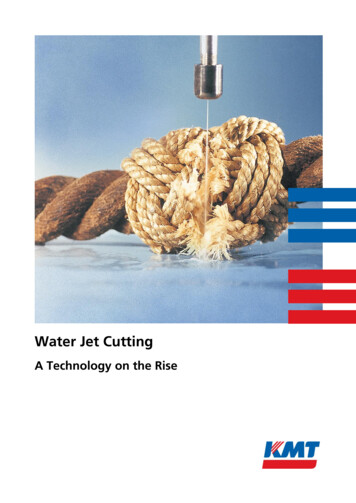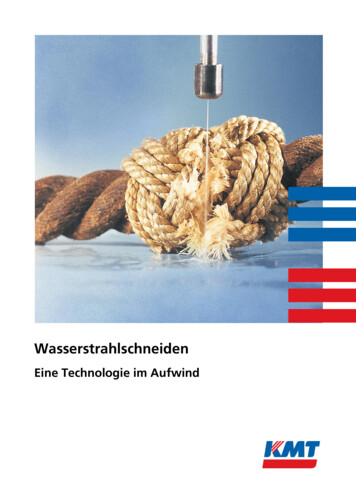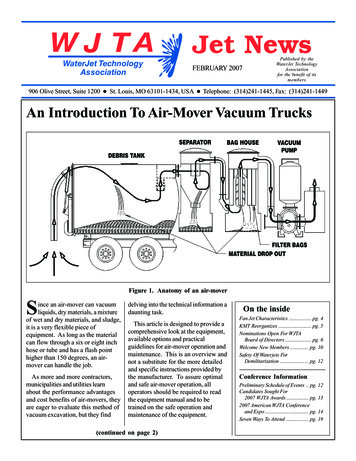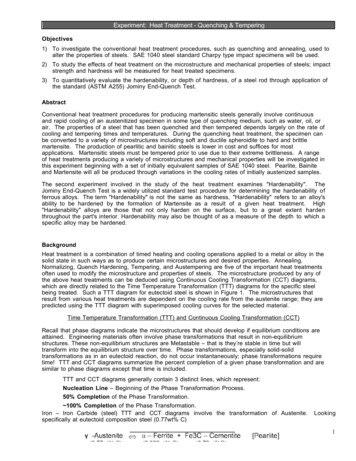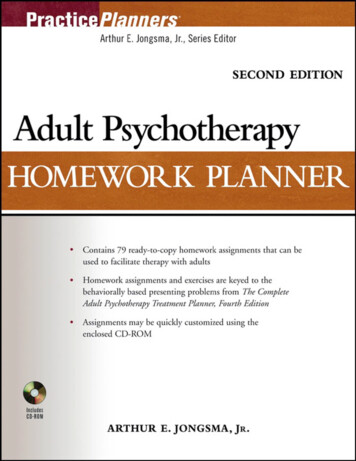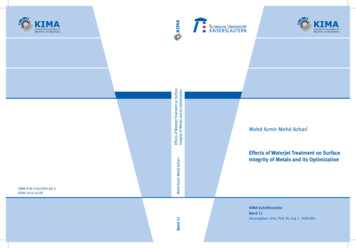
Transcription
Effects of Waterjet Treatment on SurfaceIntegrity of Metals and its OptimizationMohd Azmir Mohd Azhari –Effects of Waterjet Treatment on SurfaceIntegrity of Metals and its OptimizationKIMA SchriftenreiheBand 11Band 11ISBN 978-3-943995-60-2ISSN 1614-6220Mohd Azmir Mohd AzhariHerausgeber: Univ. Prof. Dr.-Ing. C. Schindler
Mohd Azmir Mohd AzhariEffects of Waterjet Treatment on SurfaceIntegrity of Metals and its OptimizationKIMA SchriftenreiheBand 11Herausgeber: Univ. Prof. Dr.-Ing. C. Schindler
Bibliografische Information der Deutschen NationalbibliothekDie Deutsche Nationalbibliothek verzeichnet diese Publikation in der DeutschenNationalbibliografie; detaillierte bibliografische Daten sind im Internet überhttp://dnb.d-nb.de abrufbar.Herausgeber: Fachbereich Maschinenbau und VerfahrenstechnikLehrstuhl für Konstruktion im Maschinen- und ApparatebauUniv. Prof. Dr.-Ing. C. SchindlerPostfach 3049Technische Universität Kaiserslautern, Gebäude 4267653 KaiserslauternVerlag:Technische Universität KaiserslauternDruck:Technische Universität KaiserslauternHauptabteilung 5Abteilung 5.6 Foto-Repro-DruckD-386 Fachbereich Maschinenbau und Verfahrenstechnik, Kaiserslautern 2014Alle Rechte vorbehalten, auch das des auszugsweisen Nachdrucks, der auszugsweisen oder vollständigenWiedergabe (Photographie, Mikroskopie), der Speicherung in Datenverarbeitungsanlagen und das derÜbersetzung.Als Manuskript gedruckt. Printed in Germany.ISSN 1614-6220ISBN 978-3-943995-60-2
Effects of Waterjet Treatment on SurfaceIntegrity of Metals and its OptimizationVom Fachbereich Maschinenbau und Verfahrenstechnikder Technischen Universität Kaiserslauternzur Verleihung des akademischen GradesDoktor-Ingenieur (Dr.-Ing.)genehmigte DissertationvonM.Sc. Mohd Azmir Mohd Azhariaus Perak, MalaysiaVorsitzender:Prof. Dr.-Ing. Siegfried RippergerBerichterstatter: Prof. Dr.-Ing. Christian SchindlerProf. Dr.-Ing. Eberhard KerscherDekan:Prof. Dr.-Ing. Bernd SauerTag der Einreichung:18. September 2013Tag der Mündlichen Prüfung:11. Dezember 2013Kaiserslautern, Mai 2014D 386
AcknowledgementIIIAcknowledgementFirst of all, I would like to express my deepest gratitude to the Almighty God, for Hisblessings, I am finally able to complete this work. I would like to take this opportunityto wish my sincere thanks to my ‘Doktorvater’, Prof. Dr.-Ing. Christian Schindler, forhis support and encouragement. I would also like to express my appreciation to Prof.Dr.-Ing. Eberhard Kerscher for being able to examine this work as well as giving methe opportunity to work under him during the last 3 months of my stay in Germany.I would like to give credits to those who are directly or indirectly involved in thecompletion of this work especially colleagues from ‘Lehrstuhl für Konstruktion imMaschinen- und Apparatebau (KIMA) and ‘Arbeitsgruppe Werkstoffprüfung (AWP),Technische Universität Kaiserslautern. The technical support from Lehrstuhl fürFertigungstechnik und Betriebsorganisation (FBK) and Lehrstuhl für Messtechnik undSensorik (MTS), Technische Universität Kaiserslautern, is gratefully acknowledged.I would also like to take this opportunity to thank Universiti Malaysia Pahang andGovernment of Malaysia in providing financial support during my stay in Germany.Last but not least, my most heartfelt gratitude is reserved to my mom and family fortheir undying patience, trust and belief in my endeavour.
To Fauzana, Afeef, Fatini and Aleena
Table of contentsVTable of contentsList of symbols and abbreviations . VIIKurzfassung . XZusammenfassung . XII1Introduction . 12State of the art . 32.1Methods of mechanical surface treatment . 32.1.1Shot peening process . 42.1.2Laser shock peening process . 122.1.3Waterjet peening process . 152.2Mechanics of waterjet impact . 172.2.1Liquid erosion mechanisms . 202.2.2Strengthening mechanisms . 242.3Effect of waterjet impact on surface. 262.3.1Roughness . 262.3.2Erosion . 292.4Effect of waterjet impact on sub-surface. 332.4.1Hardness . 332.4.2Microstructures . 362.5Effect of waterjet impact on fatigue life . 382.6Summary of state of the art . 423Problem specification and scientific approach . 454Research methodology . 484.1Materials . 484.2Experimental setup . 524.2.1Equipment . 524.2.2Experimental design . 534.2.3Experimental procedure . 544.3Analysis of test samples . 554.3.1Surface roughness measurement . 554.3.2Hardness measurement . 56
VITable of contents4.3.34.458Effect of waterjet peening on surface . 615.1.1Roughness . 615.1.2Erosion . 655.1.3Comparisons of surface effects between both materials . 775.2Erosion mechanisms . 795.3Effect of waterjet peening on sub-surface . 945.3.1Hardness . 945.3.2Microstructures . 1015.47Fatigue test. 58Results and discussions . 615.16Microstructural analysis . 57Effect of waterjet peening on fatigue life . 1085.4.1Fatigue life performance . 1085.4.2Surface fracture analysis . 112Optimization of the waterjet peening process . 1166.1Design of experiment. 1166.2Response surface methodology . 1176.3Analysis of results. 1206.3.1Roughness . 1206.3.2Hardness . 1246.3.3Optimization . 1346.3.4Fatigue results . 135Conclusions. 1407.1Evaluation of surface effects . 1407.2Evaluation of sub-surface effects . 1417.3Evaluation of fatigue effects . 1417.4Optimization of waterjet peening process . 142Summary and outlook . 143Literature . 145
List of symbols and abbreviationsList of symbols and abbreviationsLatin symbolsSymbolsUnitsDefinitionammRadius of the solid contact zonem/sShock velocity of the liquidm/sShock velocity of the solidm/sAcoustic velocity of the liquidDcmmCoverage diameter of the waterjetDnmmNozzle diameterDsmmAverage diameter of the shotDspotmmLaser spot diameterEpulseJLaser pulse energyEsJKinetic energy of the shotfAµmArc height on A-striphmmStandoff distanceIlaserGW/cmLaser intensityIshotmsAlmen intensitykgMass of the shotnimpactNumber of laser impactsnjNumber of waterjet passesnshotNumber of shot treatment times2Npulsepulse/mmLaser pulse densityp0MPaWaterjet supply pressurepiMPaWaterjet impact pressurepsMPaCentral stagnation pressurermmRadius of curvature of the liquid dropRaµmAverage surface roughnessRpµmMaximum peak height of the roughness profileRvµmMaximum valley depth of the roughness profileRtµmTotal height of the roughness profilevim/sImpact velocity of the liquidvnmm/minFeedrate of the waterjet nozzlevrm/sVelocity of the liquid radial flowVII
VIIIList of symbols and abbreviationsvsm/sVelocity of the shottpminPeening durationzµmDepth of the residual stress below the surfacez0µmAssumed value of the residual stress depthGreek symbolsSymbolsUnitsDefinition Contact angle of the liquid dropsDuration of the water-hammer pressureεθStrain Inclination angle of the nozzlekg/m3Density of the liquidkg/m3Density of the solidσrMPaResidual stressσr,sMPaResidual stress at the surfaceσr,maxMPaMaximum residual stressσUTSMPaUltimate tensile strengthσYSMPaYield strengthAbbreviationsAWJPAbrasive waterjet peeningCAD/CAMComputer-aided design/ computer-aided manufacturingCEMSConversion electron Mössbauer spectroscopyCJACavitating jet in airCJWCavitating jet in waterKIMAChair of Design in Mechanical EngineeringLASIKLaser in situ keratomileusisLSPLaser shock peeningNCNumerical controlOJPOil jet peeningPCPersonal computerRCWRounded cut wireRef.ReferenceTEMTransmission electron microscopy
List of symbols and abbreviationsWCPWater cavitation peeningWJPWaterjet peeningWWJWater-waterjetXRDX-ray diffraction3DThree dimensionalIX
XKurzfassungKurzfassungDie Arbeit befasst sich mit den Auswirkungen des mehrfachen Überfahrens derWerkstückoberfläche mit dem Wasserstrahl und anderen Einflussfaktoren, wieVorschub, Wasserdruck und Düsenabstand auf die Wasserstrahlbehandlung vonMetalloberflächen. Hierzu wurde die Oberflächenbeschaffenheit vor und nach derWasserstrahlbearbeitung herangezogen. Eine Erhöhung der Anzahl der Überfahrtenmit dem Wasserstrahl und eine Erhöhung des Drucks führen zu einer ften. Es lässt sich ein bestimmter Düsenabstand finden, beidem die maximale Oberflächenrauheit, Erosion und Härte entsteht. enOberflächenwurdenErkenntnisse über den Mechanismus des Materialabtrags sowie den Beginn und dieWeiterentwicklung von Schädigungen gewonnen. Basierend auf der Methode derstatistischen Versuchsplanung wurde außerdem die Oberflächenbehandlung mitWasserstrahl optimiert. Ebenfalls entwickelte Empirische Modelle zeigen eine sehrgute Korrelation zwischen gemessenen und erwarteten Ergebnissen. Eine geeigneteAuswahl der Parameter zur praktischen Anwendung kann darauf basierend erfolgen.AbstractThe study addresses the effect of multiple jet passes and other parameters namelyfeedrate, water pressure and standoff distance in waterjet peening of metallicsurfaces. An analysis of surface integrity was used to evaluate the performance ofdifferent parameters in the process. An increase in the number of jet passes andpressure leads to a higher roughness and more erosion and also a higher hardness.In contrast, the feedrate shows a reverse effect on those surface characteristics.There exists a specific value of standoff distance that results in the maximum surfaceroughness, erosion as well as hardness. Analysis of the surface microstructure gavea good insight into the mechanism material removal process involving initial andevolved damage. Also, the waterjet peening process was optimized based on thedesign of experiment approach. The developed empirical models had shownreasonable correlations between the measured and predicted responses. A proper
KurzfassungXIselection of waterjet peening parameters can be formulated to be used in practicalworks.
XIIZusammenfassungZusammenfassungFür die Wasserstrahl-Technologie gibt es verschiedene Anwendungen, wie g,EntfernungvonBeschichtungen und Randschichtverfestigung (Waterjet peening, WJP). WJP ist einerelativ neue Anwendung der Wasserstrahl-Technologie. Es handelt sich hierbei umeine mechanische Verstärkung der Oberfläche, welche durch hochfrequente Stößeder Wassertropfen mit der Werkstück-Oberfläche und der daraus bedingten lokalenplastischen Verformung bewirkt wird. Dadurch werden hohe Druckeigenspannungenin die Oberfläche induziert, was eine größere Oberflächenhärte und nnt,dassHochdruckwasserstrahlen in der Lage sind, eine starke Beschädigung derOberfläche des Werkstoffs durch Erosion zu verursachen. Diese ist durch den Stoßder sich mit hoher Geschwindigkeit bewegende Flüssigkeitsmasse mit derWerkstückoberfläche bedingt. Die vorliegende Arbeit befasst sich mit denAuswirkungen des mehrfachen Überfahrens der Werkstückoberfläche mit demWasserstrahl und anderen Einflussfaktoren, wie Vorschub, Wasserdruck undDüsenabstand auf den WJP Prozess für Edelstahl X5CrNi18-10 1.0503).EineAnalysederOberflächenbeschaffenheit in Bezug auf die Oberflächenrauheit, Abtragung, Härteund Mikrostrukturen wird verwendet, um den Einfluss verschiedener Parameter aufden WJP zu bewerten.Eine Erhöhung der Anzahl der Überfahrten mit dem Wasserstrahl führt zu einerhöheren Rauheit und Erosion auf der Oberfläche durch die wiederholte Belastungder Oberfläche mit dem Strahl. Ein hoher Wasserdruck bewirkt aufgrund der höherenkinetischen Energie der Wassermoleküle ebenfalls eine größere Oberflächenrauheitund verstärkte Erosion. Dahingegen zeigt eine Steigung des Vorschubs eineumgekehrte Wirkung auf Oberflächenrauheit und Erosionsrate. Für den Düseabstandexistierteinbestimmter Abstand,bei demderStrahl hauptsächlichausWassertröpfchen besteht, wodurch sich eine maximale Oberflächenrauheit undErosion ergibt. Die Erosion und der Materialabtrag sind bei Stahl C45 (UNS G10450)höher als bei Edelstahl X5CrNi18-10 (UNS S30400), was in der geringeren Härte desStahls C45 begründet ist. Die Mikrostruktur gibt Aufschluss über den Mechanismusdes Materialabtrags, der anfänglichen und sich entwickelnde Beschädigung.
ZusammenfassungXIIIDie Härte sinkt mit steigendem Abstand der Düse zur Oberfläche. Ein mehrfachesÜberfahren der Oberfläche mit dem Strahl und eine Erhöhung des Drucks führen zueiner größeren Härte und einer größeren Tiefenwirkung. Im Gegensatz dazu hat eineErhöhung des Vorschubs eine geringere Härte zur Folge. Für einen bestimmtenDüsenabstand wir die Härte maximal. Die wassergestrahlten Proben weisen einegeringere Schwingfestigkeit als die unbearbeiteten Proben auf, was wahrscheinlichdurch die erhöhte Oberflächenrauheit bzw. Kerbwirkung bedingt wird. Für dieDauerfestigkeit spielt die Oberflächenrauheit eine größere Rolle als die Erhöhung derHärte.In der Arbeit wurde zudem die Wasserstrahl-Randschichtverfestigung basierend aufder Methode der statistischen Versuchsplanung optimiert. Diese basiert auf denResponse-Surface-Methoden unter Verwendung des experimentellen Ansatzes nachBox-Behnken. Dabei wurde die Aluminiumlegierung AlMg1 (Werkstoffnummer3.3315) als Probenmaterial gewählt. In diesem Zusammenhang wurden empirischeModelle entwickelt, um die Oberflächenrauheit und die Härte vorherzusagen. Dieempirischen Modelle zeigen eine sehr gute Korrelation zwischen den gemessenenund erwarteten Ergebnissen. Eine geeignete Auswahl der Parameter zur praktischenAnwendung kann darauf basierend erfolgen.
This page is intentionally left blank.
1 Introduction11 IntroductionThe technology and applications of high pressure waterjet have been studied formany decades (as early as 1960s) [1]. It has been used extensively in variousindustry-related applications including machining, surface preparation, cleaning,coating removal and surface treatment like waterjet peening (WJP). In general, wateris compressed to an ultrahigh pressure up to about 700 MPa and discharged from asmall orifice typically between 0.2 to 0.4 mm in diameter [1, 2]. If abrasive is used, itis then mixed with the stream of high-velocity water in a chamber before entering thenozzle. The system produces a high velocity water stream up to 900 m/s, with orwithout abrasive particles causing damage to materials by shearing, cracking,erosion, cavitation, delamination and plastic deformation [2].In a machining process, high-pressure waterjet is used to cut a workpiece. With anaddition of abrasive particles, the machining capability of the waterjet is significantlyimproved. Various machining processes can be performed including cutting, drilling,milling, etc. A wide range of materials and thicknesses can be cut with good cuttingquality and small taper. However, different processing parameters and materialproperties have to be carefully assessed as to produce the desired cutting qualities.Using only water at a relatively low pressure, cleaning of surfaces from dirt or coatscan be achieved [3]. High pressure waterjet also is used successfully to mill coal intopowders [4].Waterjet peening (WJP) is a relatively new application of the waterjet technology [5].It is a mechanical surface strengthening process where high-frequent impact of waterdrops on the surface of metal components, which causes local plastic deformation.As a result, high compressive residual stresses are induced in the surface-near layerof the workpiece, which leads to enhanced surface hardness and fatigue life [6]. Withan addition of abrasive particles, a higher amount of compress
Herausgeber: Univ. Prof. Dr.-Ing. C. Schindler Mohd Azmir Mohd Azhari . LASIK Laser in situ keratomileusis LSP Laser shock peening NC Numerical control . Die Erosion und der Materialabtrag sind bei Stahl C45 (UNS G10450) höher als bei Edelstahl X5Cr

